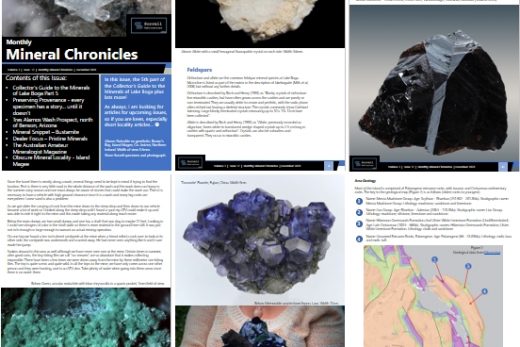The Minerals of the Kara Mine, Tasmania book (Steve Sorrell and Ralph Bottrill) can be purchased in either paperback or hardback versions from Lulu.
Featured image: Andradite, Kara Mine, Tasmania
The Kara mineral field is a group of mineralised skarn deposits, mostly worked for magnetite and scheelite, with some minor copper, lead, zinc and other mineral commodities. The deposits occur near Hampshire, about 30 km south of Burnie, in Northwest Tasmania.
The mines are a major producer of good specimen minerals, particularly andradite crystals, and there are also many rare and unusual minerals, mostly in crystalline form; the site is both a mineralogists and mineral collectors delight.
Collecting in the main open pit is heavily restricted and only available with the advance permission of the mine management, and is presently explicitly restricted to a few selected days/year. Collectors are advised to contact the Tasmanian Lapidary and Mineral Association or Northwest Tasmanian Mineral Club for details of trip times. Visitors must abide by the mine managers and TLMA’s instructions and wear adequate safety gear (steelcapped boots, hard hats, safety vests and safety glasses) at all times.
At the Kara No.1 deposit, the ore-grade scheelite and magnetite mineralisation is hosted by andradite and vesuvianite rich skarn which forms an irregularly-shaped blanket draped 15-25 m above the granite (Fig. 3). This mineralisation is separated from the granite by tungsten-poor, epidote and pyroxene rich skarns (Whitehead, 1990). The highest tungsten values are mostly within the lower parts of the magnetite-rich zones. The prograde skarns are variably retrogressed to amphibole skarns +/- epidote and fluorite.
Scheelite is disseminated mostly in magnetite-rich skarn. It is usually milky white but rarely yellow, and usually contains minor MoO3 (<3 wt.%; Khin Zaw & Singoyi, 2000). Tin is anomalous (<0.1%) in the skarn, and appears to be present in the structure of various silicates, including andradite (Whitehead, 1990), but is not recovered.
Minor sulphides are present in the skarns, and include pyrite, aikinite, molybdenite, chalcopyrite, sphalerite, arsenopyrite, bismuthinite and galena. Gold occurs in the western side of the skarn, but this mineralisation is not understood (McKeown, 1994). Hydrothermal veins and sulphides are also reported in the granite near mineralised skarn and include molybdenite, chalcopyrite and bismuthinite (McKeown, 1994).
The skarn’s weathering zone has produced some unusual secondary tungsten minerals, including mpororoite, anthoinite and stolzite, plus iron oxides and minor secondary copper minerals, in montmorillonite and halloysite-rich clays (Bottrill, 2001). The deposit was largely overlain by Tertiary basalt.



